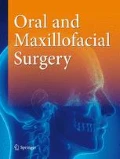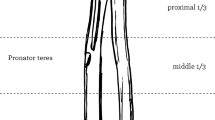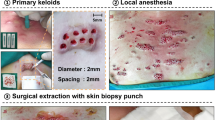Abstract
Purpose
This study aimed to compare the size of skin paddles, the postoperative course, and donor site complications between primary closure and skin grafts of the free fibula flap donor site.
Methods
Thirty-five consecutive patients were enrolled. Medical records were retrospectively reviewed for risk factors for delayed healing, size of skin paddles, time to resumption of gait with a mobility aid and self-ambulation, early donor site morbidity, and late donor site complaints.
Results
The harvested skin paddles were significantly wider in the skin graft group than in the primary closure group (P = 0.02), with no difference in length (P = 0.1). The difference in time to resuming gait with a mobility aid was also significant (P = 0.01), but not the time to self-ambulation (P = 0.9). Two early donor site morbidities (5.7 %) and 12 late donor site complaints (34.3 %) were found. No significant difference in the incidence of early donor site morbidity was observed between two groups. Occurrence of late donor site complaints was not affected by any risk factors.
Conclusions
The width of the harvested skin paddle, but not the length, is one of factors involved in donor site closure. Resumption of gait with a mobility aid, but not self-ambulation, may be delayed in skin graft patients.
Similar content being viewed by others
References
Shindo M, Fong BP, Funk GF, Karnell LH (2000) The fibula osteocutaneous flap in head and neck reconstruction: a critical evaluation of donor site morbidity. Arch Otolaryngol Head Neck Surg 126:1467–1472
Massarelli O, Gobbi R, Biglio A, Soma D, Tullio A (2014) Chimeric lateral supramalleolar artery perforator fibula free flap in the reconstruction of composite head and neck defects. Plast Reconstr Surg 133:130–136
Urken ML, Weinberg H, Buchbinder D, Moscoso JF, Lawson W, Catalano PJ et al (1994) Microvascular free flaps in head and neck reconstruction. Report of 200 cases and review of complications. Arch Otolaryngol Head Neck Surg 120:633–640
Wang YY, Fan S, Zhang DM, Lin ZY, Chen WL, Li JS (2015) Novel local full-thickness skin grafts for closure of free fibular osteocutaneous flap donor sites. J Oral Maxillofac Surg. doi:10.1016/j.joms.2015.08.015
Bach CA, Guilleré L, Yildiz S, Wagner I, Darmon S, Chabolle F (2014) Comparison of negative pressure wound therapy and conventional dressing methods for fibula free flap donor site management in patients with head and neck cancer. Head Neck. doi:10.1002/hed.23952
Momoh AO, Yu P, Skoracki RJ, Liu S, Feng L, Hanasono MM (2011) A prospective cohort study of fibula free flap donor-site morbidity in 157 consecutive patients. Plast Reconstr Surg 128:714–720
Vittayakittipong P (2013) Donor-site morbidity after fibula free flap transfer: a comparison of subjective evaluation using a visual analogue scale and point evaluation system. Int J Oral Maxillofac Surg 42:956–961
Li P, Fang Q, Qi J, Luo R, Sun C (2015) Risk factors for early and late donor-site morbidity after free fibula flap harvest. J Oral Maxillofac Surg 73:1637–1640
Bodde EW, de Visser E, Duysens JE, Hartman EH (2003) Donor-site morbidity after free vascularized autogenous fibular transfer: subjective and quantitative analyses. Plast Reconstr Surg 111:2237–2242
Akashi M, Nomura T, Sakakibara S, Sakakibara A, Hashikawa K (2013) Preoperative MR angiography for free fibula osteocutaneous flap transfer. Microsurgery 33:454–459
Yu P, Chanq EI, Hanasono MM (2011) Design of a reliable skin paddle for the fibula osteocutaneous flap: perforator anatomy revisited. Plast Reconst Surg 128:440–446
Fujiki M, Miyamoto S, Sakuraba M, Nagamatsu S, Hayashi R (2013) A comparison of perioperative complications following transfer of fibular and scapular flaps for immediate mandibular reconstruction. J Plast Reconstr Aesthet Surg 66:372–375
Sieg P, Taner C, Hakim SG, Jacobsen HC (2010) Long-term evaluation of donor site morbidity after free fibula transfer. Br J Oral Maxillofac Surg 48:267–270
Author information
Authors and Affiliations
Corresponding author
Ethics declarations
Conflict of interest
The authors indicate full freedom of investigation and no potential conflicts of interest.
Financial disclosure
There was no grant support for this study.
Rights and permissions
About this article
Cite this article
Akashi, M., Hashikawa, K., Takasu, H. et al. Comparison between primary closure and skin grafts of the free fibula osteocutaneous flap donor site. Oral Maxillofac Surg 20, 233–237 (2016). https://doi.org/10.1007/s10006-016-0556-3
Received:
Accepted:
Published:
Issue Date:
DOI: https://doi.org/10.1007/s10006-016-0556-3




